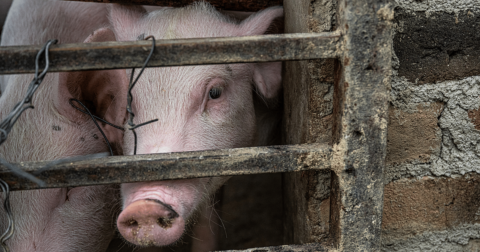Explainer
How Overconsumption Affects the Environment and Health, Explained
Climate•12 min read
Reported
A new report uncovers global climate investors looking to boost industrial pork and poultry.


Words by Sophie Kevany
Factory farms will feed the world, or so goes Big Ag’s rallying cry. With a growing global population and shrinking space for farmland, we have no choice but to rely on industrial meat and dairy to feed the nearly 10 billion people who will populate the planet by 2050.
A new report released today from Compassion in World Farming challenges that notion — arguing that industrial agriculture fails to do what it claims to be best at: producing cheap, low-emission animal protein.
The report also highlights a newer concern: under the guise of climate action, global development funds appear poised to direct more dollars to industrial pork and poultry farms, over beef.
The report’s findings tell a story of “vast indirect subsidies and government support,” said Alex Blanchette, Tufts University associate anthropology professor and meat industry ethnographer. Blanchette, who was not involved in the NGO report, said that without “publicly-funded science, research and universities,” the industries supporting intensive farming “would struggle to exist.”
Yet the precise role of public sector subsidies — specifically whether these funds are the reason that industrial meat is cheap — has been the subject of much debate. Some researchers argue that certain types of intensively produced animal protein — especially chicken and eggs — are now so cheap to produce that national funders aren’t what are driving costs down.
That cheap price comes with plenty of hidden costs, however, including healthcare bills, animal suffering, dirty air and polluted waterways. Add in those costs, and cheap meat becomes anything but.
According to a document drafted by the European Investment Bank for multinational development banks in 2021, non-ruminant meat — essentially pork and poultry farms — are a climate-friendly investment option, based on what the CIWF report calls the ‘myth’ of ‘Paris Alignment’ , the idea that cheap chicken and pork is aligned with global climate targets. The endorsement means the farms could attract millions more investment dollars.
In April of this year, the International Finance Corporation (IFC), a member of the World Bank Group, disclosed details of a proposed $47 million loan to expand multi-story pork operations housing more than a million pigs per year in China’s Guangxi province.
The loan, according to IFC documents, would be used as working capital by “four existing multi-story pig farm buildings with an annual production of 32,000 breeding sows and a feed mill with processing capacity of 200,000 metric tons to support existing pig farm operations.” Media reports say the pig farms, located in China’s Yaji Mountain Forest Park, have seven stories, and one may have as many as 13.
This comes on top of an $80 million investment in the same project made in March 2021. A new petition by NGO Sinergia Animal aims to stop another IFC loan to Brazilian dairy giant, Alvoar Lacteos, following a video report alleged animal cruelty, including calf starvation, at farms supplying the company.
Responding to criticisms that the IFC is funding climate change, antibiotic resistance, deforestation and animal cruelty, and that neither intensive pig nor poultry farming should be considered ‘Paris aligned’, a spokesperson told Sentient Media: ”IFC works with livestock clients that are committed to enhancing animal health and welfare, protecting the environment, and promoting food safety. IFC works closely with clients to build more environmentally sustainable operations.”
In a Food Tank op-ed last June, however, CIWF report author, Peter Stevenson, and Kari Hamerschlag, a director of Friends of the Earth’s agriculture program, argued against “Paris-aligned” factory farm financing.
If industrial meat companies had to pay for the damage they cause — whether it be pollution clean-up, healthcare bills or reducing animal cruelty — it’s likely cheap meat would have to cost a lot more.
While ruminant meat like beef is a leading driver of food-related emissions, so-called climate-friendly meats like chicken and pork are harmful in other ways and cost the public billions. These farms pollute air and waterways — with nitrogen from pig manure lagoons and ammonia from chicken litter for instance — and are terrible for the animals raised in these systems.
Another expensive problem is the rising global threat of antibiotic-resistant disease thanks to all kinds of meat — ruminant and non-ruminant alike. Despite calls from public health experts to curb the rampant overuse of antibiotics, industrial operations continue to feed these drugs to animals as standard operating procedure.
According to research cited in the report, 2.4 million people could die from superbug infections in Europe, North America and Australia between 2015 and 2050. The same superbugs could cause infections costing up to US$3.5 billion per year, over the next 30 years.
Meanwhile, a joint report by the FAO, WHO and other agencies calculates that making no changes to the way we eat would send global diet-related health costs from diseases like coronary heart disease, stroke, cancer and type-2 diabetes soaring — exceeding $1.3 trillion annually by 2030.
Beyond these hidden costs, the CIWF report suggests other reasons to doubt the notion that factory farming is necessary to feed the world.
What’s often left out of this rationale, the report says, is the massive amount of food we waste each year — some of which is lost on farms and the rest by consumers. According to researchers at the World Resources Institute, feeding a growing global population sustainably requires a number of solutions deployed at the same time — including more people shifting to a plant-based diet and curbing their food waste. Both of these solutions, along with rewilding, would be a more sustainable alternative to just producing more factory farmed meat.
The CIWF report drills down on just how crucial it is that we curb how much food we waste — citing United Nations calculations from 2021 pointing to households, food service and retailers as the culprits behind 17 percent of global food waste.
Experts say households in wealthier countries waste more than poorer ones, which means residents of global north countries need to eat less, and throw away fewer, animal protein foods to help reduce climate warming emissions.
The other oft-missed point in the efficiency argument is just how much land the livestock industry uses to raise meat — both the animals themselves and feed crops. Meats like beef and lamb require about 100 times more land compared to plant-based alternatives. Cheese, milk, pigs and poultry require about 23 times more, 15 times more, seven times more and six times more, respectively.
Most of the corn and soy we grow goes to feed animals rather than people — one 2013 study cited in the report found that “36% of the calories produced by the world’s crops are being used for animal feed, and only 12% of those feed calories ultimately contribute to the human diet (as meat and other animal products).”
Another huge inefficiency is how much of the factory farm system’s crops goes to fuel. Globally, the report said, 10 percent of all grain is turned into climate-unfriendly biofuels. If instead, those grains were used for food, an extra 1.9 billion people would eat.
Switching even a fraction of the many resources that go toward animal protein production into more efficient food systems would be transformational, suggests Blanchette. In this respect, he said, the report “reveals what may well be the most fundamental waste of all: the remarkable diversion of human time, energy, knowledge and scientific resources needed to keep mass-producing animals.”